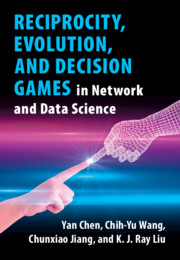Book contents
- Frontmatter
- Contents
- Preface
- 1 Basic Game Theory
- Part I Indirect Reciprocity
- Part II Evolutionary Games
- Part III Sequential Decision-Making
- 11 Introduction to Sequential Decision-Making
- 12 Chinese Restaurant Game: Sequential Decision-Making in Static Systems
- 13 Dynamic Chinese Restaurant Game: Sequential Decision-Making in Dynamic Systems
- 14 Indian Buffet Game for Multiple Choices
- 15 Hidden Chinese Restaurant Game: Learning from Actions
- 16 Wireless Network Access with Mechanism Design
- 17 Deal Selection on Social Media with Behavior Prediction
- 18 Social Computing: Answer vs. Vote
- Index
14 - Indian Buffet Game for Multiple Choices
from Part III - Sequential Decision-Making
Published online by Cambridge University Press: 01 July 2021
- Frontmatter
- Contents
- Preface
- 1 Basic Game Theory
- Part I Indirect Reciprocity
- Part II Evolutionary Games
- Part III Sequential Decision-Making
- 11 Introduction to Sequential Decision-Making
- 12 Chinese Restaurant Game: Sequential Decision-Making in Static Systems
- 13 Dynamic Chinese Restaurant Game: Sequential Decision-Making in Dynamic Systems
- 14 Indian Buffet Game for Multiple Choices
- 15 Hidden Chinese Restaurant Game: Learning from Actions
- 16 Wireless Network Access with Mechanism Design
- 17 Deal Selection on Social Media with Behavior Prediction
- 18 Social Computing: Answer vs. Vote
- Index
Summary
Users may have multiple concurrent options regarding different objects/resources and their decisions usually negatively influence each other’s utility, which makes the sequential decision-making problem more challenging. In this chapter, we introduce an Indian buffet game to study how users in a dynamic system learn about the uncertain system state and make multiple concurrent decisions by not only considering their current myopic utility, but also the influence of subsequent users’ decisions. We analyze the Indian buffet game under two different scenarios: one of customers requesting multiple dishes without budget constraints and the other with budget constraints. In both cases, we design recursive best-response algorithms to find the subgame-perfect Nash equilibrium for customers and characterize special properties of the Nash equilibrium profile in a homogeneous setting. Moreover, we introduce a non-Bayesian social learning algorithm by which customers can learn the system state, and we theoretically prove its convergence. Finally, we conduct simulations to validate the effectiveness and efficiency of the Indian buffet game.
Information
- Type
- Chapter
- Information
- Publisher: Cambridge University PressPrint publication year: 2021
